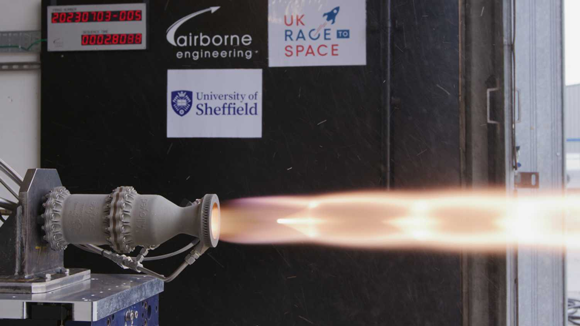University of Sheffield students build and test additively manufactured liquid rocket engine
July 13, 2023

The UK’s University of Sheffield has reported that students have built and successfully tested an additively manufactured liquid rocket engine, said to be the most powerful student-built engine of its type.
As part of the Race to Space competition, teams from various UK universities participated in testing rocket engines they had built over the past two academic years, with the competition believed to have set an unofficial world record for the number of different hybrid/liquid rocket engines hot-fired for the first time on one site in one week.
Unlike a jet engine, the liquid rocket uses both fuel and oxidiser, rather than breathing in oxygen. It is also the first engine that is regen-cooled, meaning that it uses fuel to cool the combustion chamber before it is burnt, increasing the engine’s efficiency and reducing its weight.
Only a few liquid rocket engines have been made by students throughout Europe, and even fewer regen engines have been made worldwide. Until now, none had been made in the UK using Additive Manufacturing and none had been as powerful as this engine.
The students reportedly built the engine over the past two years as part of the University of Sheffield’s Space Initiative, a programme aimed at helping STEM students apply their skills to tackle challenges in the space industry and develop careers in the field. Their goal is to one day use the engine to power their own rockets to the edge of space and become the first UK student-led team to cross the Kármán line, which borders Earth’s atmosphere at 62 miles above sea level.
Engineering graduate and former Sunride Project Manager, Dana Arabiyat, shared, “Two years and countless hours of hard work later, the successful hot-fire of our engine got us jumping for the most unforgettable five seconds of our lives! This achievement is a testament to the incredible talent and commitment of our Project SunFire team members and leads, and to the tireless mentorship and supervision of Dr Alistair John.”
Dr Alistair John, Deputy Director of Aerospace Engineering at the University of Sheffield, who supervised the team, added, “Additive manufacturing (3D printing) is increasingly being used by rocket companies such as SpaceX as it allows you to build complex, lightweight custom geometries that would not be possible using traditional methods. For example, the cooling channels in our engine, which stop the engine melting despite the 2,000°C combustion temperature, can only be made using 3D printing.”
“Extra-curricular activities such as Sunride and the Race to Space initiative are hugely important as they allow students to apply the knowledge from their degree and push the boundaries of what they can achieve. It is hugely important for the UK space sector that we give our students hands-on, practical experience to develop the skills industry needs,” John added.
The engine was test fired at Airborne Engineering at the Westcott Space Cluster and additively manufactured at the Satellite Applications Catapult with the build process optimisation work done under the MAPP EPRSC future manufacturing hub.
More information on the Sunride team
More information on the University of Sheffield’s Space Initiative
Download Metal AM magazine

















